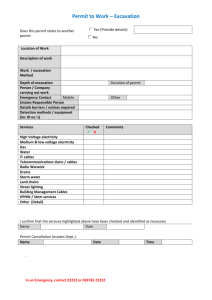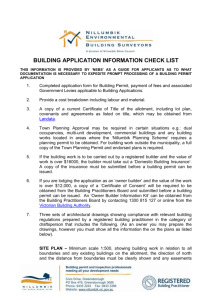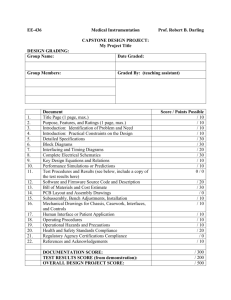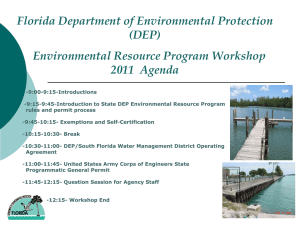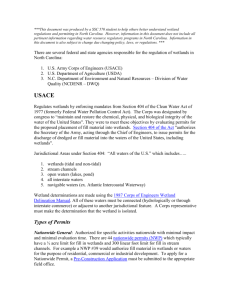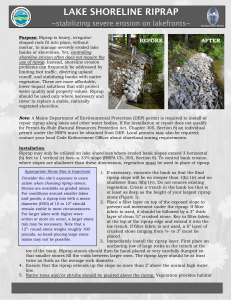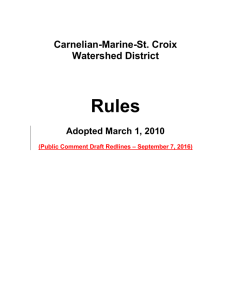Section D
advertisement
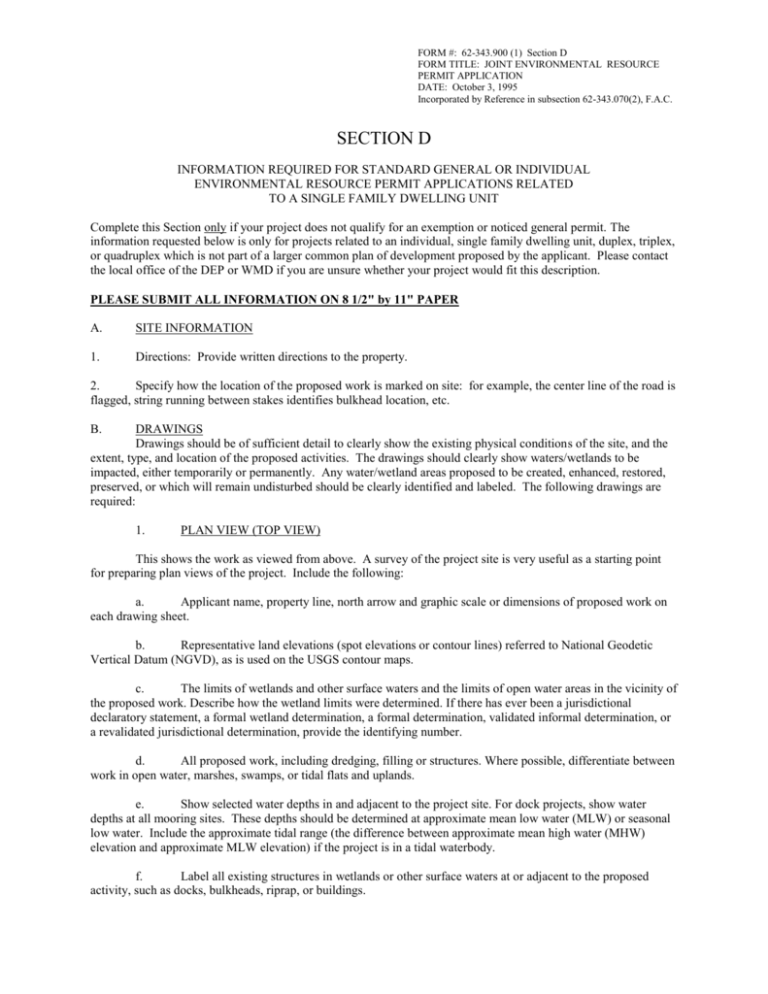
FORM #: 62-343.900 (1) Section D FORM TITLE: JOINT ENVIRONMENTAL RESOURCE PERMIT APPLICATION DATE: October 3, 1995 Incorporated by Reference in subsection 62-343.070(2), F.A.C. SECTION D INFORMATION REQUIRED FOR STANDARD GENERAL OR INDIVIDUAL ENVIRONMENTAL RESOURCE PERMIT APPLICATIONS RELATED TO A SINGLE FAMILY DWELLING UNIT Complete this Section only if your project does not qualify for an exemption or noticed general permit. The information requested below is only for projects related to an individual, single family dwelling unit, duplex, triplex, or quadruplex which is not part of a larger common plan of development proposed by the applicant. Please contact the local office of the DEP or WMD if you are unsure whether your project would fit this description. PLEASE SUBMIT ALL INFORMATION ON 8 1/2" by 11" PAPER A. SITE INFORMATION 1. Directions: Provide written directions to the property. 2. Specify how the location of the proposed work is marked on site: for example, the center line of the road is flagged, string running between stakes identifies bulkhead location, etc. B. DRAWINGS Drawings should be of sufficient detail to clearly show the existing physical conditions of the site, and the extent, type, and location of the proposed activities. The drawings should clearly show waters/wetlands to be impacted, either temporarily or permanently. Any water/wetland areas proposed to be created, enhanced, restored, preserved, or which will remain undisturbed should be clearly identified and labeled. The following drawings are required: 1. PLAN VIEW (TOP VIEW) This shows the work as viewed from above. A survey of the project site is very useful as a starting point for preparing plan views of the project. Include the following: a. Applicant name, property line, north arrow and graphic scale or dimensions of proposed work on each drawing sheet. b. Representative land elevations (spot elevations or contour lines) referred to National Geodetic Vertical Datum (NGVD), as is used on the USGS contour maps. c. The limits of wetlands and other surface waters and the limits of open water areas in the vicinity of the proposed work. Describe how the wetland limits were determined. If there has ever been a jurisdictional declaratory statement, a formal wetland determination, a formal determination, validated informal determination, or a revalidated jurisdictional determination, provide the identifying number. d. All proposed work, including dredging, filling or structures. Where possible, differentiate between work in open water, marshes, swamps, or tidal flats and uplands. e. Show selected water depths in and adjacent to the project site. For dock projects, show water depths at all mooring sites. These depths should be determined at approximate mean low water (MLW) or seasonal low water. Include the approximate tidal range (the difference between approximate mean high water (MHW) elevation and approximate MLW elevation) if the project is in a tidal waterbody. f. Label all existing structures in wetlands or other surface waters at or adjacent to the proposed activity, such as docks, bulkheads, riprap, or buildings. FORM #: 62-343.900 (1) Section D FORM TITLE: JOINT ENVIRONMENTAL RESOURCE PERMIT APPLICATION DATE: October 3, 1995 Incorporated by Reference in subsection 62-343.070(2), F.A.C. g. If dredging or dewatering is involved, show the location of proposed disposal or containment sites. Include any levees, control structures or other methods for retaining or detaining return water. Also include locations of discharge sites where appropriate. (Note that a consumptive or water use permit may be required for dewatering.) h. For piling supported structures over wetlands or other surface waters, show the entire structure. Indicate the location of any aquatic vegetation in the vicinity of the proposed structure. i. Show distance between the most waterward point of the proposed facility and the nearest edge of any navigation channel, where appropriate. If the project is on a waterway that has a federally maintained channel, a survey may be required to establish the distance from the waterward points of the structure to the near edge of the federal channel. Also indicate the width of the waterway. j. drawings. 2. Clearly show the locations of all corresponding cross-sectional or profile views on the plan view CROSS-SECTIONAL AND PROFILE VIEWS The cross-sectional view should show a "cut-away" end or middle view of the project, while the profile view should show a side view as if cut length-wise. All drawings should include: a. Applicant name and graphic horizontal and vertical scales or dimensions of the proposed work on each drawing sheet. b. C. Show approximate mean or seasonal (high and low) water line elevations referenced to NGVD. PROJECT DETAILS Provide a detailed description of the proposed project, including the following: 1. The type of activity that is proposed, how the activity will be conducted, construction techniques and sequencing, including equipment to be used, and methods for moving the equipment to and from the site. For projects that involve any dredging or excavation, describe the method of excavation, the type of material to be excavated, and the disposal location for the excavated material. State whether dredged material is to be placed (either temporarily or permanently) in a wetland or other surface water. Indicate the time period any temporary structures will be in place. 2. The acreage (or square footage) of excavation and fill and differentiate between temporary and permanent work. 3. Methods for controlling turbidity (muddy water caused by erosion or work in the water). 4. Methods for stabilizing any slopes that will be created or disturbed during construction, including times expected to elapse before stabilization is performed. Describe both temporary and permanent stabilization methods, such as staked hay bales, temporary grass seed, and permanent sod. 5. If pilings or a seawall are to be installed state whether pilings and seawall slabs are to be installed by jetting or driving. 6. For fill projects, describe the source and type of fill material to be used. For activities that involve the installation of riprap, describe the source, type and size of the rocks, concrete, or other material to be used for the riprap, and how these materials are to be placed. State whether the rocks will be underlain with filter cloth
